Earth and Dirt Tangle Meaning

Everywhere you look in Cuzco, you see the colors of the landscape: the white of clouds and the blue of sky, as well as the orangy brown of dirt. Sometimes this terra-cotta color is only the tiles made from fired clay that covers roofs in the colonial core, and sometimes it seems a wash, like what the city’s water colorists use, that tints all of life.
Cuzco Eats recently published an article on the earth and dirt by Arnold Fernandez Coraza which left me thinking. As I translated it, I was struck by the ways in which dirt–tierra, in Spanish–lies at the foundation and forms the substance of so much of Cuzco’s life.
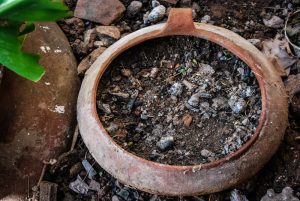
It literally is the ground on which the people live and make their buildings. At the same time, from it is formed the adobes that make so many of their homes, especially the older ones or the poorer ones. From it are also made traditional ovens and stoves, as well as cooking pots and eating utensils. Of course food comes from it, and sometimes it is used as medicine and some people even eat it directly in special circumstances.
Fernandez called this dirt “tierra” and then referred to it as the Madre Tierra, a word that in English means Mother Earth. We English speakers do not call her Mother dirt, one of the key meanings of the Spanish, although maybe we should. Instead we use a word that seems to reference something else, the planet, our planet, covered with water and vegetation.
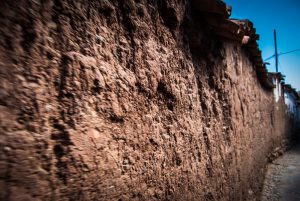

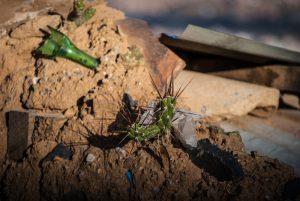
Yet in earth’s earliest usages, according to the Online Etymology Dictionary, the word was Anglo Saxon and referred–like the Spanish tierra–to the “ground, soil, dry land.” It came to be the planet with the development of celestial observation, around 1400, more than a century before the great Galileo.
If this is right, it means that I, as an English speaker, see the word very differently from my colleagues from Cuzco.* I see it as something that arises after the revolution of thinking that developed from seeing our planet as rotating around the sun, rather than being the basis of everything. My way comes after Europe plowed the seas, and sowed empire everywhere, including into space. That is part of why my language focuses on water and green.
This emphasis on water and green strikes me as really weird. I grew up in a desert, in the US drylands of the South West where the color of earth is often unmediated by vegetation, or that vegetation is spiny and can hurt you. Yet my language’s image of the Earth is more like the green of England than the brown of my homeland because the English ruled the world and science such that their notions of a good landscape got fused with the image of the planet.
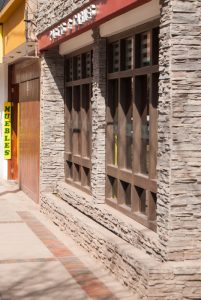
The earlier “ground, soil, dry land” seems to have disappeared as the primary meaning of earth, even though those words are so important in English.
It should not surprise us, perhaps, that it was the very English anthropologist Mary Douglas who provided the most important essay on the word dirt. She simply noted that dirt had ceased to refer primarily to the earth, but had become a message about things out of place or disorderly. She beautifully captured the English word that causes such pain and feelings of properness “dirty”. It is as if the English used the land as something to react against in their cultivation of a civilized people and they claimed the effluvia of the earth for the task.
This separation is just not so easily available in Spanish and certainly not in Andean Spanish. Fernandez wrote that the earth is the Earth Mother, which is how I translated his words “Madre Tierra” though perhaps I should have said Mother Dirt. He did not mean that nice and pristine, green and blue world of the English, but the stuff that makes mud and from which adobes, stoves, medicine, and food come. But he did not mean anything disorderly or out of place.
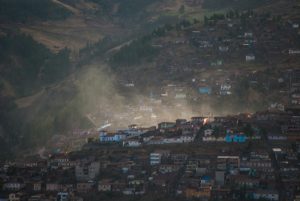
The great womb of the earth, its inside, from which life germinates and grows is dirt, like the qurpas (clods) from which the over for baking potatoes (huatia) is made.
This just makes it so hard for an English speaker such as me to make sense of what I see when I walk in nice neighborhoods and see dirt on the side walk or bare earth where I would expect gardens. It is hard when I look at walls of dirt slowly melting with every rain storm, or un plastered-houses of mud bricks (adobes). It is hard when I see the wash of terra cotta that seems to stain everything as the days wear on, or when I go to the neighborhoods on the hillsides and see streets of dirt, children playing in dirt. It is hard when I see winds pick up the dirt as dust to stir it and blow it as August, the month of winds. For me dust storms are the primary meaning of a wind with dirt, while here the primary meaning is that it is time to go out and fly kites.
I confuse dirt with dirty and with things out of place instead of seeing it as the Mother, the ground, and source of all things good.
If Fernandez’ Andean Spanish is this hard to place in English, you can begin to imagine the difficulties that must appear when one is dealing with the indigenous languages of Quechua and Aymara. Their words and value systems around dirt and earth just do not easily line up with the English.
We are the products of our culture and history and they of theirs, even if our worlds intersect. The need to translate makes me ever more aware of difference and its difficulties.
* To be sure, the meaning of planet is a meaning for the word tierra in Cuzco’s Spanish. It does not seem the dominant one, but rather one that requires specifying. The dominant meaning is that enshrined in the words Pachamama, or Mother Earth, the hills around the people and the ground on which they live.




